User:Palm dogg/United Nations intervention in Somalia
Somalia
| Operation Restore Hope | |||||||||||
|---|---|---|---|---|---|---|---|---|---|---|---|
| Part of the Somali Civil War | |||||||||||
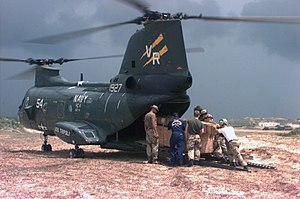 | |||||||||||
| |||||||||||
| Participants | |||||||||||
|
| United Somali Congress | ||||||||||
| Commanders and leaders | |||||||||||
|
| Mohamed Farrah Aidid | ||||||||||
| Casualties and losses | |||||||||||
|
82 killed
~300 wounded
| Unknown | ||||||||||
| United Nations Operation in Somalia II | |||||
|---|---|---|---|---|---|
| Part of the Somali Civil War | |||||
| |||||
| Belligerents | |||||
| United Somali Congress | ||||
| Commanders and leaders | |||||
|
|
| ||||
| Strength | |||||
| 30,000 personnel, including 22,000 troops and 8,000 logistic and civilian staff | Unknown | ||||
| Casualties and losses | |||||
|
| 1,000+ killed, 3,000+ wounded, 22 captured | ||||
The United Nations Intervention in Somalia was a series of three United Nations (UN) sponsored interventions in the early 1990s to provide humanitarian relief and political stability in Somalia during the Somali Civil War. All three operations were intended to establish a secure enough environment for humanitarian operations to be carried out, because there was effectively no central government and the country was increasingly subject to factional violence and was suffering from famine, in part due to the warfare and social disruption. The operation was initially established by the United Nations Security Council (UNSC) in April 1992 as United Nations Operation in Somalia I (UNOSOM I) and ran until December 1992. In December, after the UN Security Council decided that UNOSOM I was ineffectual, the Council passed Resolution 794, authorizing the United States-led Unified Task Force (UNITAF) to create a protected environment for conducting humanitarian operations in the southern half of the country. By March 1993 the famine had largely ended, the United States withdrew most of its forces, and UNITAF passed its mission off to United Nations Operation in Somalia II (UNOSOM II) in May 1993. UNSOM II had a more ambitious mandate focusing on political stability and security, and the United Nations rapidly came into conflict with one of Somalia's most powerful warlords, Mohamed Farah Aideed. After Aideed's militia killed 24 United Nations peacekeepers in early June, the Security Council changed UNOSOM II's mandate to explicitly target Aideed. A series of battles between UN and US forces against Aideed's militia in the summer and fall of 1993 ultimately led to the Battle of Mogadishu, where twenty-one UN/US soldiers and up to 2,000 Somalis were killed. US soldiers completely withdrew from Somalia in March 1994, followed by other Western nations. In November 1994, the UN Security Council voted unanimously to withdraw the remaining 1,900 UNOSOM II troops. The withdrawal of the remaining UN military and police troops from Somalia was completed on March 28, 1995, thereby ending UNOSOM II's mandate and the UN intervention.
Despite the UN's success in helping to end the Somali famine, the subsequent battles with Aideed's militia have caused the operation to largely be viewed as a failure, and had direct ramifications on other UN peacekeeping operations, especially in Rwanda and Bosnia. It caused significant tensions between UN Secretary General Boutros Boutros-Ghali and the United States, and played a key role in the US veto to deny Boutros-Ghali a second term.
The UN's intervention in Somalia was the first time UN troops had been used in a direct combat role since the Congo in the early 1960s. It is also one of the most ambitious uses of UN troops under Chapter VII.
Background
A general understanding of Somalia's geography, demography and culture is important in this analysis. Somalia sits on the Horn of Africa at the Entrance of the Gulf of Aden and the Red Sea. Djibouti to the North, Ethiopia to the West and Kenya to the South provides its borders of approximately 8.5 million people, more than 98 percent are Somali giving it unusual ethnic homogeneity. More than 45 percent of the population are under 15 years of age. About 70 percent of Somali's are nomads who travel with their livestock, herds through Somalia, Kenya and Ethiopia. A lack of definite borders contributes to the unresolved land disputes between Somalia and its neighbors.
Following the eruption and escalation of the civil war in Somalia in 1991, the UN and the Organization of African Unity (OAU) intervened, citing the war and starvation. Of the Somali population of 10 million people, over half were in severe danger of starvation and malnutrition-related disease, mostly in the drought-stricken rural areas.
Another 1.5 million were judged at moderate risk of malnutrition. Three hundred thousand people died outright in the early months of 1992 and another 3 million fled the country as refugees.[10]
The UN was engaged in Somalia from early in 1991 when the civil strife began. UN personnel were withdrawn on several occasions during sporadic flare-ups of violence. A series of Security Council resolutions (733, 746) and diplomatic visits eventually helped impose a ceasefire between the two key factions, signed at the end of March 1992. These efforts were aided by other international bodies, such as the Organisation for African Unity, the League of Arab States and the Organisation of the Islamic Conference.
Creation

The UN, with the active support of all rebel faction leaders, felt that some sort of peacekeeping force would be required to uphold the ceasefire and assist the humanitarian relief effort, in conjunction with other relief agencies and NGOs. By the end of April 1992, the Security Council adopted Resolution 751.
This provided for the establishment of a security force of 50 UN troops in Somalia to monitor the ceasefire. This detachment would be known as the United Nations Operation in Somalia (UNOSOM) and it existed at the consent of those parties who had been represented in the ceasefire.
The resolution also allowed for an expansion of the security force, with a number of around 500 troops initially discussed. The first group of ceasefire observers arrived in Mogadishu in early July 1992.
Ineffectiveness
Despite the UN's efforts, all over Somalia the ceasefire was ignored, fighting continued, and continued to increase, putting the relief operations at great risk. The main parties to the ceasefire, General Mohamed Farrah Aidid and "President" Ali Mahdi Muhammad, once again showing the difficult and troubled relations between the warlords, proved to be difficult negotiating partners and continually frustrated attempts to move the peacekeepers and supplies.
In August 1992 the Security Council endorsed the sending of another 3,000 troops to the region to protect relief efforts. However, most of these troops were never sent.
Over the final quarter of 1992, the situation in Somalia continued to get worse. Factions in Somalia were splintering into smaller factions and splintering again. Agreements for food distribution with one party were worthless when the stores had to be shipped through the territory of another.
Some elements were actively opposing the UNOSOM intervention. Troops were shot at, aid ships attacked and prevented from docking, cargo aircraft were fired upon and aid agencies, public and private, were subject to threats, robbery and extortion. Meanwhile, hundreds, if not thousands of poverty stricken refugees were starving to death every day.
By November 1992, General Mohamed Farrah Aidid had grown confident enough to formally defy the Security Council and demand the withdrawal of peace keepers, as well as declaring hostile intent against any further UN deployments.[11]
Transition to UNITAF and UNOSOM II
In November 1992, the United States of America offered to establish a multinational force under its own leadership to secure the humanitarian operation. This offer was accepted by the Security Council, and what became known as the Unified Task Force (UNITAF) was authorized to utilize "all necessary means" to ensure the protection of the relief efforts.
Accordingly, the Security Council suspended any further significant strengthening of UNOSOM as UN affairs in Somalia were subsumed by UNITAF (also known to Americans as Operation Restore Hope). With only a handful of the 3,000 plus troops envisaged for UNOSOM ever put in place, the Security Council left it to “the discretion of the Secretary General” as to what should be done with the abortive mission.[12]
UNITAF was composed of forces from 24 different countries, with the vast bulk contributed by the United States. UNITAF soon secured the relief operations which were being coordinated and carried out by UNOSOM, which was also attempting to negotiate a political end to the conflict. Indeed, although UNOSOM had been replaced by UNITAF, it was technically still in operation and would remain ready to resume its function when UNITAF had met its goals of creating a secure environment for humanitarian relief.
The Secretary-General convened a meeting in early 1993 in which 14 important Somalia political and rebel factions agreed to hand over all of their weapons to UNITAF and UNOSOM, and over $130 million was pledged by donors at an aid conference that year to assist in reconstruction. However, Somalia continued the stumble, and in March the UN decided to transform the UNITAF mission into what came to be known as UNOSOM II. The mandate of UNOSOM II stipulated that the operation was to secure continued relief efforts and, more significantly, to restore peace and rebuild the Somali state and economy.
Statistics

In the few months of its operation, 54 military observers and 893 military personnel served with UNOSOM I, supported by international civilian and local staff. The mission suffered six fatalities. Contributing nations were: Australia, Austria, Belgium, Canada, Czech Republic, Egypt, Fiji, Finland, Indonesia, Jordan, Morocco, New Zealand, Norway, Pakistan, and Zimbabwe.[13]
See also
References
- ^ "United Nations Operation in Somalia UNSOM 1992". Australian War Memorial. Retrieved 31 May 2009.
- ^ "American War and Military Operations Casualties: Lists and Statistics" (PDF). Fas.org. Retrieved 4 October 2018.
- ^ "Peacekeeping Contributor Profile: Australia". Retrieved 14 December 2017.
- ^ "Peacekeeping Contributor Profile: Austria". Retrieved 14 December 2017.
- ^ "Peacekeeping Contributor Profile: Bangladesh". Retrieved 14 December 2017.
- ^ "Peacekeeping Contributor Profile: Belgium". Retrieved 14 December 2017.
- ^ "Peacekeeping Contributor Profile: France". Retrieved 14 December 2017.
- ^ "Peacekeeping Contributor Profile: Germany". Retrieved 13 December 2017.
- ^ "India - Somalia Relations" (PDF). Ministry of External Affairs. February 2016. Retrieved 3 April 2017.
- ^ United Nations, 2003, United Nations Operations in Somalia (UNSOM 1) Background (Full Text) Archived January 10, 2007, at the Wayback Machine
- ^ United Nations, 1992, Letter dated 92/11/24 from the Secretary-General addressed to the President of the Security Council.
- ^ United Nations, Security Council resolution 794 (1992), 24/4/92, para. 3.
- ^ United Nations Operation in Somalia I: facts and figures Archived September 19, 2006, at the Wayback Machine
Further reading
- Allard, Colonel Kenneth, Somalia Operations: Lessons Learned, National Defense University Press (1995).
External links
Background
Faced with a humanitarian disaster in Somalia, exacerbated by a complete breakdown in civil order, the United Nations had created the UNOSOM I mission in April 1992. However, the complete intransigence of the local faction leaders operating in Somalia and their rivalries with each other meant that UNOSOM I could not be performed. The mission never reached its mandated strength.[1]
Over the final quarter of 1992, the situation in Somalia continued to worsen. Factions were splintering into smaller factions, and then splintered again. Agreements for food distribution with one party were worthless when the stores had to be shipped through the territory of another. Some elements were actively opposing the UNOSOM intervention. Troops were shot at, aid ships attacked and prevented from docking, cargo aircraft were fired upon and aid agencies, public and private, were subject to threats, looting and extortion.[1] By November, General Mohamed Farrah Aidid had grown confident enough to defy the Security Council formally and demand the withdrawal of peacekeepers, as well as declaring hostile intent against any further UN deployments.[2]
In the face of mounting public pressure and frustration, UN Secretary-General Boutros Boutros-Ghali presented several options to the Security Council. Diplomatic avenues having proved largely fruitless, he recommended that a significant show of force was required to bring the armed groups to heel. Chapter VII of the Charter of the United Nations allows for "action by air, sea or land forces as may be necessary to maintain or restore international peace and security." Boutros-Ghali believed the time had come for employing this clause and moving on from peacekeeping.[3]

However, Boutros-Ghali felt that such action would be difficult to apply under the mandate for UNOSOM. Moreover, he realised that solving Somalia's problems would require such a large deployment that the UN Secretariat did not have the skills to command and control it. Accordingly, he recommended that a large intervention force be constituted under the command of member states but authorised by the Security Council to carry out operations in Somalia. The goal of this deployment was "to prepare the way for a return to peacekeeping and post-conflict peace-building".[1]
Following this recommendation, on 3 December 1992 the Security Council unanimously adopted Resolution 794, authorizing the use of "all necessary means to establish as soon as possible a secure environment for humanitarian relief operations in Somalia". The Security Council urged the Secretary-General and member states to make arrangements for "the unified command and control" of the military forces that would be involved.[4]
UNITAF has been considered part of a larger state building initiative in Somalia, serving as the military arm to secure the distribution of humanitarian aid. However, UNITAF cannot be considered a state building initiative due to its specific, limited and palliative aims, which it nonetheless exercised forcefully'. The primary objective of UNITAF was security rather than larger institution building initiatives.[5]
Composition
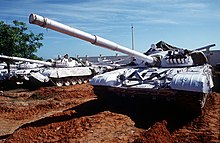
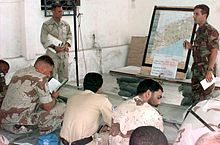

The vast bulk of UNITAF's total personnel strength was provided by the United States (some 25,000 out of a total of 37,000 personnel). Other countries that contributed to UNITAF were Australia, Bangladesh, Belgium, Botswana, Canada, Egypt, Ethiopia, France, Germany, Greece, India, Ireland, Italy, Kuwait, Morocco, New Zealand, Nigeria, Norway, Pakistan, Saudi Arabia, Spain, Sweden, Tunisia, Turkey, United Arab Emirates, the United Kingdom, and Zimbabwe.[6]
The U.S. Central Command (USCINCCENT) established Joint Task Force (JTF) Somalia to perform Operation Restore Hope. The I Marine Expeditionary Force (I MEF) staff made up the core of the JTF headquarters. (The name of this command started as CJTF Somalia but changed to United Task Force-UNITAF). The CJTF commanded Marine forces from I MEF (referred to as MARFOR Somalia) and Army forces from the 10th Mountain Division (referred to as ARFOR Somalia), as well as Air Force and Navy personnel and units.[7] There were also special operations forces components, in addition to the forces provided by countries contributing to the US-led, combined coalition.
The national contingents were co-ordinated and overseen by U.S. Central Command, however, the relationship between CentCom and the contributing nations varied. There were a few confrontations over the methods and mandates employed by some contingents. For example, the Italian contingent was accused of bribing local militias to maintain peace, whilst the French Foreign Legion troops were accused of over-vigorous use of force in disarming militiamen.[8] The Canadian contingent of the operation was known by the Canadian operation name Operation Deliverance.
United States
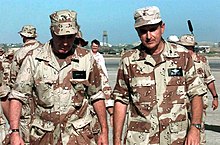
Prior to Resolution 794, the United States had approached the UN and offered a significant troop contribution to Somalia, with the caveat that these personnel would not be commanded by the UN. Resolution 794 did not specifically identify the U.S. as being responsible for the future task force, but mentioned "the offer by a Member State described in the Secretary-General's letter to the Council of 29 November 1992 (S/24868) concerning the establishment of an operation to create such a secure environment".[9] Resolution 794 was unanimously adopted by the United Nations Security Council on 3 December 1992, and they welcomed the United States offer to help create a secure environment for humanitarian efforts in Somalia.[10] President George H. W. Bush responded to this by initiating Operation Restore Hope on 4 December 1992, under which the United States would assume command in accordance with Resolution 794.[11]
Larry Freedman, a CIA paramilitary officer from the Special Activities Division, became the first U.S. casualty of the conflict in Somalia when his vehicle struck an anti-tank mine. He had been inserted prior to official U.S. presence on a special reconnaissance mission, serving as a liaison between the U.S. Embassy and the arriving military forces while providing intelligence for both. Freedman was a former Army Delta Force operator and Special Forces soldier and had served in every conflict that the United States was involved in both officially and unofficially since Vietnam. Freedman was awarded the Intelligence Star for extraordinary heroism.

The first Marines of UNITAF landed on the beaches of Somalia on 9 December 1992 amid a media circus. The press "seemed to know the exact time and place of the Marines' arrival" and waited on the airport runway and beaches to capture the moment.[12]
Critics of U.S. involvement argued that the U.S. government was intervening so as to gain control of oil concessions for American companies,[13] with a survey of Northeast Africa by the World Bank and UN ranking Somalia second only to Sudan as the top prospective producer.[14] However, no American and UN troops were deployed in proximity to the major oil exploration areas in the northeastern part of the country or the autonomous Somaliland region in the northwest. The intervention happened twenty-two months after the fall of Barre's regime.[15] Other critics explain the intervention as the administration's way to maintain the size and expenditures of the post-Cold War military establishment, to deflect criticism for the president's failure to act in Bosnia, or to leave office on a high note.[15] To many in the administration, the intervention seemed like an optimal case for the use of military force – the chances of success seemed high, while the political risks and the danger to U.S. troops appeared to be limited. Acting Secretary of State Eagleburger described the situation in Somalia as "a tragedy of massive proportions, and, underline this, one that we could do something about.”[16]
Operation
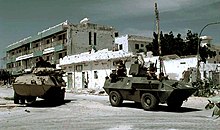
The operation began on 6 December 1992, when Navy SEALs and special warfare combatant-craft crewmen from Naval Special Warfare Task Unit TRIPOLI began conducting beach and port hydrographic and reconnaissance survey operations in the vicinity of the landing beach, airport, and harbor. These operations lasted three days. In the early hours of 8 December 1992, elements of the 4th Psychological Operations Group attached to the 15th Marine Expeditionary Unit (MEU) conducted leaflet drops over the capital city of Mogadishu.[17][18] At 0540, on 9 December, the MEU performed a combined methods of entry amphibious assault into the city of Mogadishu and surrounding areas from USS Tripoli, USS Juneau, and USS Rushmore.[19][20] Although initially unopposed, the uncertain operating environment required using nonlinear, simultaneous forcible entry operations along multiple lines of operation from selected afloat and ashore basing throughout the amphibious operations area.[21]
The MEU's ground combat element, Battalion Landing Team (BLT) 2nd Battalion, 9th Marines (2/9) along with Delta Battery 2nd Battalion 12th Marines, performed simultaneous ship to objective amphibious assaults on the Port of Mogadishu and Mogadishu International Airport, establishing a foothold for additional incoming troops.[22] Echo and Golf Company assaulted the airport by helicopter and Amphibious Assault Vehicles, while Fox Company secured the port with an economy of force rubber boat assault. The 1st Marine Division's Air Contingency Battalion (ACB), 1st Battalion, 7th Marines, as well as 3rd Battalion, 11th Marines (3/11 is an artillery battalion but operated as a provisional infantry battalion while in Somalia), arrived soon after the airport was secured. Elements of BLT 2/9's India Co, and 1/7 went on to secure the airport in Baidoa and the city of Bardera, while BLT 2/9's Golf Company, and elements of the Belgian Special Forces, conducted an amphibious landing at the port city of Kismayo. Air support was provided by the combined helicopter units of HMLA-267, HMH-363, HMH-466, HMM-164, and HC-11's DET 10.
Concurrently, various Somali factions returned to the negotiating table in an attempt to end the civil war. This effort was known as the Conference on National Reconciliation in Somalia and it resulted in the Addis Ababa Agreement signed on 27 March 1993.[23] The conference, however, had little result as the civil war continued afterwards.
Results

As UNITAF's mandate was to protect the delivery of food and other humanitarian aid, the operation was regarded as a success.[24] United Nations Secretary-General Boutros Boutros-Ghali determined that the presence of UNITAF troops had a "positive impact on the security situation in Somalia and on the effective delivery of humanitarian assistance."[25] An estimated 100,000 lives were saved as a result of outside assistance.[26]
One day prior to the signing of the Addis Ababa Agreement, the United Nations Security Council passed Resolution 814, which marked the transfer of power from UNITAF to UNOSOM II, a United Nations led force. The major change in policy that the transition from UNITAF to UNOSOM II entailed is that the new mandate included the responsibility of nation-building on the multinational force.[27] On 3 May 1993, UNOSOM II officially assumed command, and on 4 May 1993 it assumed responsibility for the operations.
Operation Continue Hope provided support of UNOSOM II to establish a secure environment for humanitarian relief operations by providing personnel, logistical, communications, intelligence support, a quick reaction force, and other elements as required. Navy ships were involved, from the unit USS Peleliu Amphibious Readiness Group. The ships included the ship USS Anchorage LSD-36, USS Peleliu, USS Duluth, USS Frederick. The Marine units from 11th Marine Expeditionary Unit (MEU) were involved. The USS Anchorage docked at the port of Mogadishu and spent several days there. Over 60 Army aircraft and approximately 1,000 aviation personnel operated in Somalia from 1992 to 1994.
No disarmament of the rivaling factions within Somalia was undertaken.[28] This meant that the situation stayed stable only for the time UNITAF's overwhelming presence was deterring the fighting. Therefore, the mandate to create a "secure environment" was not achieved in a durable fashion. The Canadian Airborne Regiment was disbanded due to its conduct at UNITAF that was revealed during an investigation into the Somalia Affair.[citation needed]
Transition

UNITAF was only intended as a transitional body.[citation needed] Once a secure environment had been restored, the suspended UNOSOM mission would be revived, albeit in a much more robust form. On 3 March 1993, the Secretary-General submitted to the Security Council his recommendations for effecting the transition from UNITAF to UNOSOM II. He noted that despite the size of the UNITAF mission, a secure environment was not yet established and there was still no effective functioning government or local security/police force.[1] The Secretary-General concluded therefore, that, should the Security Council determine that the time had come for the transition from UNITAF to UNOSOM II, the latter should be endowed with enforcement powers under Chapter VII of the United Nations Charter to establish a secure environment throughout Somalia.[1] UNOSOM II would therefore seek to complete the task begun by UNITAF for the restoration of peace and stability in Somalia. The new mandate would also empower UNOSOM II to assist the Somali people in rebuilding their economic, political and social life, through achieving national reconciliation so as to recreate a democratic Somali State.[citation needed]
UNOSOM II was established by the Security Council in Resolution 814 on 26 March 1993 and formally took over operations in Somalia when UNITAF was dissolved on 4 May 1993.[29]
References
Footnotes
- ^ a b c d e Cite error: The named reference
THE-FINAL-CALLwas invoked but never defined (see the help page). - ^ United Nations, 1992, Letter dated 92/11/24 from the Secretary-General addressed to the President of the Security Council.
- ^ United Nations, 1992, Letter dated 92/11/29 from the Secretary-General addressed to the President of the Security Council, page 6.
- ^ United Nations, Security Council resolution 794 (1992), 24 April 1992, para. 3
- ^ Caplan, Richard (2012). Exit Strategies and State Building. New York: Oxford University Press. p. 86. ISBN 978-0199760121.
- ^ "UNITED NATIONS OPERATION IN SOMALIA II (UNOSOM II) - Background (Summary)". peacekeeping.un.org. Retrieved 16 September 2021.
- ^ Relations with Humanitarian Relief Organizations: Observations from Restore Hope, Center for Naval Analysis
- ^ Patman, R.G., 2001, ‘Beyond ‘the Mogadishu Line’: Some Australian Lessons for Managing Intra-State Conflicts’, Small Wars and Insurgencies, Vol, 12, No. 1, p. 69
- ^ "Security Council resolutions – 1992". Un.org. Retrieved 29 January 2012.
- ^ Security Council Resolution 794
- ^ Bush, George H., Address to the Nation on the Situation in Somalia, 4/12/92 On 23 December 1992,
- ^ Johnston, Dr. Philip (1994). Somalia Diary: The President of CARE Tells One Country's Story of Hope. Atlanta, Georgia: Longstreet Press. p. 73. ISBN 1-56352-188-1.
- ^ Fineman, Mark (18 January 1993). "Column One; The Oil Factor In Somalia;Four American Petroleum Giants Had Agreements With The African Nation Before Its Civil War Began. They Could Reap Big Rewards If Peace Is Restored". Los Angeles Times: 1. Archived from the original on 24 February 2012.
- ^ Hassan, Abdiqani (21 May 2008). "Canada's Africa Oil starts Somalia seismic survey". Reuters. Retrieved 26 August 2020.
- ^ a b Adam, Dr. Hussein M. (2008). From Tyranny to Anarchy: The Somali Experience. Trenton, NJ: The Red Sea Press, Inc. pp. 156–160. ISBN 978-1-56902-288-7.
- ^ Baum, Matthew A. (June 2004). "How Public Opinion Constrains the Use of Force: The Case of Operation Restore Hope". Presidential Studies Quarterly. 34 (2): 187–226. doi:10.1111/j.1741-5705.2004.00028.x. ISSN 0360-4918.
- ^ Friedman, Herbert A. "United States PSYOP in Somalia". Psywarrior. Retrieved 2 December 2012.
- ^ Borchini, Charles P. (Lt. Col.); Borstelmann, Mari (October 1994). "PSYOP in Somalia: The Voice of Hope" (PDF). Special Warfare. United States Army. Retrieved 2 December 2012.[permanent dead link]
- ^ Buer, Eric F. (Maj.) (2002). "A Comparative Analysis of Offensive Air Support" (PDF). United States Marine Corps Command and Staff College. p. 23.
- ^ Mroczkowski, Dennis P. (Col.) (2005). Restoring Hope: In Somalia with the Unified Task Force 1992–1993 (PDF). United States Marines Corps. pp. 31–34. Retrieved 13 February 2020.
- ^ Joint Publication 3-0 (17 January 2017). Joint Operations (Incorporating Change 1, 22 October 2018 ed.). Joint Chiefs of Staff: US Government Printing Office. pp. V-17 to V-18, VIII-12 to VIII-13, GL-10.
{{cite book}}: CS1 maint: numeric names: authors list (link) - ^ Joint Publication 3-02 (4 January 2019). "Chapter II – Types of Amphibious Operations, Chapter IV – Planning Phase" (PDF). Amphibious Operations. Joint Chiefs of Staff: US Government Printing Office. pp. II-9 to II-13, IV-4 to IV-19.
{{cite book}}: CS1 maint: numeric names: authors list (link) - ^ "The General Agreement signed in Addis Ababa on 8 January 1993". United States Institute of Peace. Archived from the original on 29 December 2006. Retrieved 30 November 2019.
- ^ "Operation Restore Hope". Globalsecurity.org. Retrieved 2 December 2007.
- ^ "United Nations Operation in Somalia I". Retrieved 2 December 2007.
- ^ Clarke, Walter; Herbst, Jeffrey (31 August 2017). "Somalia and the Future of Humanitarian Intervention". Foreign Affairs.
- ^ "United Nations Operation in Somalia 2". Un.org. Retrieved 2 December 2007.
- ^ Norrie MacQueen (2006). Peacekeeping and the International System. Routledge.[ISBN missing]
- ^ Brune, Lester H. (1998). The United States and Post-cold War Interventions: Bush and Clinton in Somalia, Haiti, and Bosnia, 1992–1998. Regina Books. p. 33. ISBN 978-0941690904.
Bibliography
- Allard, C. K. (1995). Somalia Operations: Lessons Learned. Washington: National Defense University Press. ISBN 978-0160455773.
- Miller, L. L.; Moskos, C. (1995). "Humanitarians or warriors?". Armed Forces Soc. 21 (4): 615–637. doi:10.1177/0095327x9502100406. S2CID 144654522.
- Stevenson, J. (1995). Losing Mogadishu: testing U.S. policy in Somalia. Annapolis: Naval Institute Press. ISBN 978-1557507884.
- Stewart, R. W. (2002). The United States Army in Somalia, 1992–1994. Washington: Government Printing Office. ISBN 978-0160676796.
